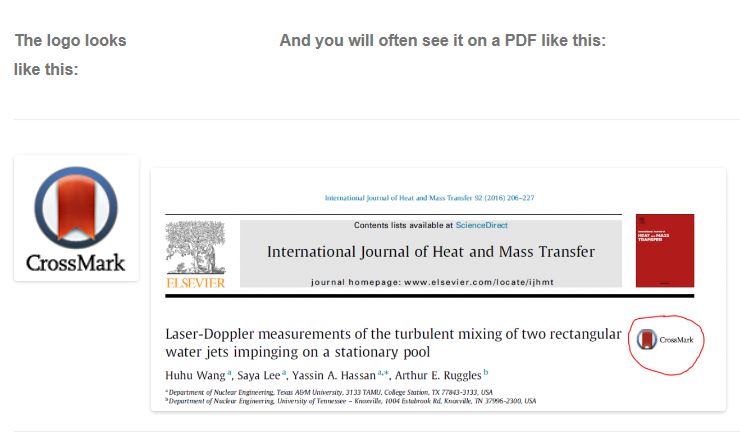Click on the CrossMark logo for peace of mind!
07/12/2015

Think how embarrassed you would feel if you cited a paper that had been retracted! A retraction means that the publisher has withdrawn the paper.
I helped a student recently who had found an article he wanted to cite in his work. It wasn’t until we viewed the publisher’s version of the PDF that we saw a ‘retracted’ watermark. It had been retracted because large parts of it had been found to be plagiarised from another journal article. We had been checking the publisher’s version for something else so it was pure luck that we spotted it. This experience brought home to me how hard it can be to find information about retractions and updates to scholarly publications.
The CrossMark scheme from CrossRef is designed to make finding the current status of an article easy. Increasing numbers of publishers are including a CrossMark logo on the PDF or web version of an article (or indeed a book, conference paper or any other scholarly publication). If the logo is present and you are online, click on it each time you open the document, even if you’ve saved it locally. It’s a live link that will give you up to date information about the status of the article. If it has been corrected, retracted or updated you will be able to find out and take appropriate action.
|
|
Click on the logo and you will see one of two things:
The green tick is good news! It confirms that the version you are looking at is current and a DOI link to the publisher’s version is given.
The blue exclamation mark means that a correction has been made to the paper.
A click on the DOI of this one shows that the spelling of an author name has been corrected – in this case nothing that would prevent you citing the paper.
For further information and a very helpful video visit http://www.crossref.org/crossmark/.
You may also find Retractionwatch.com interesting. This is a blog that tracks retractions from the scholarly literature and provides a commentary for each.
Emma Turner is Aerospace Information Specialist and works in the Kings Norton Library. If you have any queries about this, please contact Emma.
Categories & Tags:
Leave a comment on this post:
You might also like…
Keren Tuv: My Cranfield experience studying Renewable Energy
Hello, my name is Keren, I am from London, UK, and I am studying Renewable Energy MSc. My journey to discovering Cranfield University began when I first decided to return to academia to pursue ...
3D Metal Manufacturing in space: A look into the future
David Rico Sierra, Research Fellow in Additive Manufacturing, was recently involved in an exciting project to manufacture parts using 3D printers in space. Here he reflects on his time working with Airbus in Toulouse… ...
A Legacy of Courage: From India to Britain, Three Generations Find Their Home
My story begins with my grandfather, who plucked up the courage to travel aboard at the age of 22 and start a new life in the UK. I don’t think he would have thought that ...
Cranfield to JLR: mastering mechatronics for a dream career
My name is Jerin Tom, and in 2023 I graduated from Cranfield with an MSc in Automotive Mechatronics. Originally from India, I've always been fascinated by the world of automobiles. Why Cranfield and the ...
Bringing the vision of advanced air mobility closer to reality
Experts at Cranfield University led by Professor Antonios Tsourdos, Head of the Autonomous and Cyber-Physical Systems Centre, are part of the Air Mobility Ecosystem Consortium (AMEC), which aims to demonstrate the commercial and operational ...
Using grey literature in your research: A short guide
As you research and write your thesis, you might come across, or be looking for, ‘grey literature’. This is quite simply material that is either unpublished, or published but not in a commercial form. Types ...








